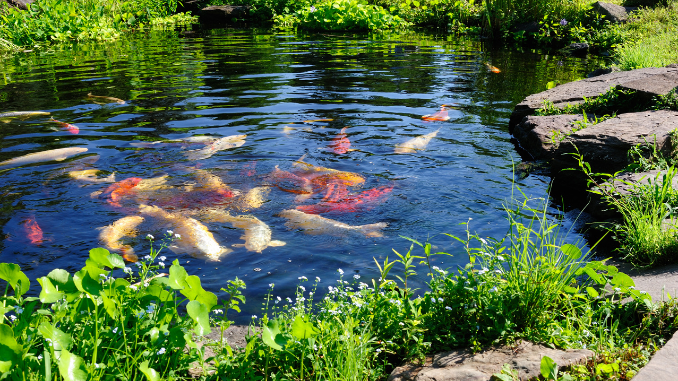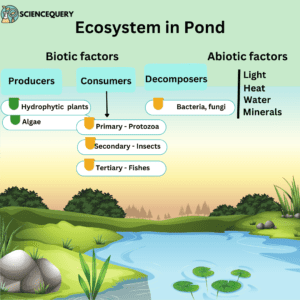
An ecosystem is a dynamic complex of plant, animal, and microorganism communities and the non-living environment, interacting as a functional unit.
A pond is either a natural or an artificial body of water that is enclosed. Ponds can occur naturally in the world or they can be human-made such as garden ponds. The pond ecosystem differs from other water ecosystems because, in the pond ecosystem, the water remains stagnant for a relatively longer period.
Significance of pond ecosystem
- Freshwater habitats support biodiversity and provide habitat to species that need it the most. Several species live here.
- A pond works as a mini-reservoir that drains fields when it rains.
- In ponds, nutrients are recycled and phosphates and nitrates are reduced.
- They contribute to the beauty of Mother Nature.
Role in ecological landscape
The various roles a pond ecosystem plays in conserving ecological balance are (1)
- They provide habitat for numerous aquatic organisms and provide a breeding ground for them.
- They are natural filters as they remove pollutants and excess nutrients from water, thus cleaning them.
- Ponds offer a source of recreation such as birdwatching, fishing, and studying.
- Ponds support a variety of plant and animal species and conserve biodiversity.
Abiotic components of a pond ecosystem

The major abiotic components of the pond ecosystem are (2)
1. Water
It is the most important component for the survival of the pond ecosystem. It provides a habitat for aquatic creatures. The acidity or alkalinity of water is a determining factor for the growth of various animals in ponds.
2. Sunlight
The amount of sunlight that penetrates the water’s surface affects the growth of aquatic plants and helps them with photosynthesis.
3. Temperature
Temperature can vary seasonally in ponds and affect the metabolic rates and behaviors of aquatic organisms.
4. Nutrients
Nutrient levels, including nitrogen and phosphorus, influence the growth of algae other bacteria, and other plants in the pond ecosystem.
Biotic components of the pond ecosystem
There are three types of biotic components in the pond ecosystem primary, they are as follows (3, 4,5)
1. Producers
- The main producers in pond ecosystems are algae and other aquatic plants such as Azolla, Hydrilla, Potamogeton, Pistia, Wolffia, Lemna, Eichornia, nymphaea, etc.
- These are either floating suspended or rooted at the bottom.
- The green plants convert the radiant energy into chemical energy through photosynthesis.
- The chemical energy stored in the form of food is utilized by all organisms.
- Oxygen evolved by producers in photosynthesis is utilized by all living organisms in respiration.
The main types of producers and their functions are
-
Phytoplankton
These are microscopic algae that float in the open water and give it a green appearance. Tarry out photosynthesis using carbon dioxide that is dissolved in the water and release oxygen that is used by the bacteria and animals in the pond.
-
Periphytic algae
They are microscopic algae that attach themselves to substrates and give the rocks and sticks a greenish-brown slimy appearance. Also carry out photosynthesis and produce oxygen, often near the bottom of the pond where it can be used by decomposers.
-
Submerged plants
Grow completely underwater.
-
Floating plants
These are rooted in shallow water but their stems and leaves are above water most of the time.
-
Shore plants
They grow in wet soil at the edge of the pond.
2. Consumers
In a pond ecosystem, the primary consumers are tadpole larvae of frogs, fishes, and other aquatic animals which consume green plants and algae as their food. These herbivorous aquatic animals are the food of secondary consumers. Frogs, big fishes, water snakes, and crabs are secondary consumers. In the pond, besides the secondary consumers, there are consumers of higher order, such as water birds, turtles, etc, The main types of consumers are
-
Zooplankton
These are microscopic animals that eat phytoplankton or smaller zooplankton. They float about in the open water portions of the pond and are important food for some animals.
-
Invertebrates
Include all animals without backbones. Macroinvertebrates are big enough to be seen with the naked eye.
- Vertebrates
These are animals with backbones. In a pond, these might include fish, fogs, salamanders, and turtles.
3. Decomposers
When aquatic plants and animals die, a large number of bacteria and fungi attack their dead bodies and convert the complex organic substances into simpler inorganic compounds and elements. These microorganisms are called decomposers. Chemical elements liberated by decomposers are again utilized by green plants in their nutrition. Decomposers are also known as detritivores.
Nutrient cycle in pond ecosystem
- The nutrient cycle in the pond is important for the balance of nutrients required by aquatic flora and fauna.
- Nutrients enter the pond through rainfall, surface rainfall, etc.
- Aquatic plants like phytoplankton intake nutrients.
- They are being fed by large aquatic animals which automatically transfer nutrients.
- When the herbivores and carnivores die, their decomposed bodies release nutrients back into the water after getting broken down by the action of bacteria.
- The nutrients are again taken by primary producers and the cycle continues (6).
Human impact on the pond ecosystem
The significant impacts of human activities in the pond ecosystem are (7)
- Pollution: pollution from agriculture, urban runoff, and industrial waste introduces harmful substances into pond waters. This leads to degradation of water quality and harms aquatic life.
- Invasive species: humans sometimes unintentionally introduce invasive or alien species to the pond ecosystem which disrupts the native flora and fauna.
- Overfishing: it leads to the depletion of the fish population in ponds, upsetting the ecological food web in ponds.
- Climate change: climatic changes caused by human activities lead to changes in temperature and rainfall patterns impacting the hydrology of the pond ecosystem.
- Recreation: recreational activities like boating, swimming, and fishing disturb the natural wildlife and natural habitat of ponds.
Summary
- A pond ecosystem is a community of organisms that live in a pond.
- The biotic factors in the pond ecosystem are producers, consumers, and decomposers.
- The abiotic factors are sunlight, temperature, rainfall, etc.
- These abiotic factors help the pond ecosystem to survive.
- The nutrient cycle in the pond ecosystem is the constant source of energy for the aquatic biome.
- Human disturbances like pollution, overfishing, etc are slowly destroying the pond ecosystem.
- With proper conservation and management methods, the pond ecosystem can be restored properly.
Reference
- Binay Karna. Lucents general knowledge.Lucent publication, Patna.Chapter 04- Environment, Page no:178-182.
